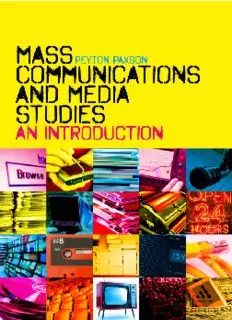
Mass Communications and Media Studies: An Introduction PDF
Preview Mass Communications and Media Studies: An Introduction
Mass Communications and Media Studies This page intentionally left blank Mass Communications and Media Studies An Introduction Peyton Paxson 2010 The Continuum International Publishing Group Inc 80 Maiden Lane, New York, NY 10038 The Continuum International Publishing Group Ltd The Tower Building, 11 York Road, London SE1 7NX www.continuumbooks.com Copyright © 2010 Peyton Paxson All rights reserved. No part of this book may be reproduced, stored in a retrieval system, or transmitted, in any form or by any means, electronic, mechanical, photocopying, recording, or otherwise, without the written permission of the publishers. Library of Congress Cataloging-in-Publication Data Paxson, Peyton. Mass communications and media studies : an introduction / by Peyton Paxson. p. cm. Includes bibliographical references and index. ISBN-13: 978-1-4411-0895-1 (pbk. : alk. paper) ISBN-10: 1-4411-0895-5 (pbk. : alk. paper) 1. Mass media. I. Title. P90.P357 2010 302.23–dc22 2010003641 ISBN: 978-1-4411-0895-1 Typeset by Newgen Imaging Systems Pvt Ltd, Chennai, India Printed and bound in the United States of America by Sheridan Books, Inc Contents Acknowledgments vi A Note to the Reader . . . vii 1 Mass Communications and Contemporary Culture 1 2 Media Studies and Media Literacy 18 3 Advertising 32 4 Television 50 5 Radio and Music 71 6 Print Media 91 7 Movies and Video 112 8 The Internet 129 9 New Media 151 10 Disaggregation and Convergence 171 11 Mass Communications and the Legal Environment 190 12 Globalization 208 Notes 225 Glossary 240 Index 249 Acknowledgments To Katie Gallof at Continuum, who made it happen. To my dean, Clea Andreadis, and my program chair, Michelle Bloomer, for letting it happen. To my old pal Francine Taylor, for keeping it real. To my wife and best friend Karen L. Muncaster. To my family in El Paso. And to my brother-in-law, Bob Muncaster, who will read this book in a big brown truck. Thank you all. A Note to the Reader . . . Nearly 20 years ago, a 10-year-old asked me what I thought about “The Crisis in the Gulf.” I thought it was odd that a child would use such an expression. I later discovered that he had learned the term from CNN, which used it as its “branding” of its coverage of the first Gulf war. Mass communications are more than a source of entertainment and information. They affect how we see the world and how we see ourselves. Yet because they are so embedded in our lives, it is easy for us to take mass communications for granted. This book doesn’t do that. Chapter 1 looks at the cultural, social, and economic roles that mass communications serve. Chapter 2 discusses the need for each of us to be media literate, and provides a framework for thinking critically about the media. The mass communications industry arose in the United States in the 1800s, as the Industrial Revolution generated the need for mass marketing and mass media. For two centuries, mass communications was essentially a one-way process, with information and entertainment created and delivered by the mass media to individuals. Chapters 4 through 8 examine “traditional” media: television, radio, print media, and movies. These chapters look at how each communications medium arose and discuss the current industry structure of each. Most traditional media are essentially advertising delivery vehicles. This should be obvious for broadcast and print media, and advertising plays a larger role in movies than you may realize. The structure of the advertising industry is discussed in Chapter 3, and the role advertising plays in each medium is examined in the chapters devoted to those media. Chapters 8 and 9 focus on the Internet and what are commonly referred to as “new” media. New media include social networking, mobile commu- nications devices, and video games. The interactivity of these media and their ability to let users view media whenever and wherever they want are posing serious threats to traditional media. Chapter 10 examines the disaggregation of audiences and the convergence of media. We will see that these relatively recent phenomena provide new viii A Note to the Reader . . . opportunities to consumers and new challenges to the media industry. The role that law and government regulation play in shaping and controlling the mass communications industry is the topic of Chapter 11. We know that globalization is an increasingly important process. The book concludes with a discussion of how mass communications both affect globalization and are affected by it. Each chapter ends with thoughts about the future of each topic, as well as a discussion of career opportunities that these topics present. There are also a handful of questions at the end of each chapter that ask you to engage in critical thinking and discussion of the topics presented. This book provides a condensed introduction to mass communications. Its brevity and lack of color illustrations serve to make this book an accessible and affordable alternative to other books in the field. 1 Mass Communications and Contemporary Culture Chapter contents Issues and trends in mass communications and contemporary culture 1 Mass communications 2 Contemporary culture 12 Mass communications and careers 14 Issues and trends in mass communications and contemporary culture • Interpersonal communications have existed as long as humanity; mass communications are a relatively recent development. • Mass media in the past lacked the ability to quickly receive feedback from their audi- ences, but new communication technology provides increased interactivity. • Just as interpersonal communications allow people to establish relationships with each other, mass communications serve a role in building and maintaining communities. • Mass communications are distributed through mass media, which arose during the American Industrial Revolution of the 1800s to provide mass marketing for firms that mass manufactured products. • Mass markets are segmented into numerous characteristics, including people’s age, income, and attitudes. • Half a dozen firms control many of the major media channels in the United States.
